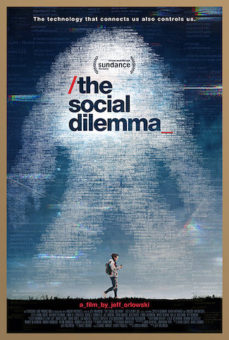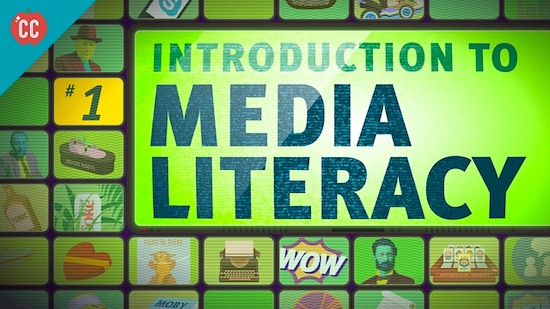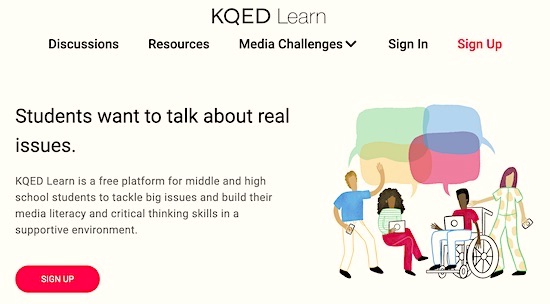Teaching 7th Graders Social Media Literacy
A MiddleWeb Blog
 You may have seen it trending in your Netflix feed. It’s been in the Top 10 trending films for the past few weeks. The documentary The Social Dilemma is a topic of conversation on television, radio, podcasts, and among my 7th graders – and it’s one focus of a new class I’m teaching.
You may have seen it trending in your Netflix feed. It’s been in the Top 10 trending films for the past few weeks. The documentary The Social Dilemma is a topic of conversation on television, radio, podcasts, and among my 7th graders – and it’s one focus of a new class I’m teaching.
Media Literacy is one of the elective courses our middle school students have in their schedules this year. Could there be a more urgent time to be teaching it?
The definition of media literacy – according to the National Association for Media Literacy Education (NAMLE) – is “the ability to ACCESS, ANALYZE, EVALUATE, CREATE, and ACT using all forms of communication.”
Throughout the last five weeks my students have been looking at public service announcements (PSAs), propaganda, infomercials, and current events online as they develop their media literacy skills. There is no doubt in my mind that my students’ eyes are being opened to the world of media manipulation and their need for such skills.
Finding out more about their media lives
I started this new adventure by asking them some simple questions to gear them up for the class.
- Do you have a cell phone?
- Do you have any social media accounts?
- TikTok?
- Snapchat?
- Facebook?
- YouTube?
- How many hours per day do you think you spend on social media and the web?
- Are you allowed to keep your phone in your room at night?
- What are the rules in your house for technology?
By asking my students these questions, I was able to establish a base for some of my instruction through the first few weeks.
Among the things I found out: My 7th grade students spend an average of 4-5 hours per day on their phones. In all honesty, because of the pandemic, I figured it would be much higher. Also, in terms of social media platforms, it seems more students are trending away from Facebook and using TikTok.
I was encouraged that my 13-year old students were spending less time online than many adults believe they are (assuming the kids’ estimates are reliable). But after our five weeks together exploring media through a literacy lens, I’m not fully convinced they understand the consequences of some of the content they consume on websites and through social media.
We began with a crash course
After I gained a better sense of where my students stood, we worked our way through a 12-part Media Literacy series put together by Crash Course, the YouTube channel created by John and Hank Green (who are also popular YA authors).
Crash Course is dedicated to providing educational videos to everyone for free. There are video courses on literature, world history, math, and chemistry, to just name a few. And it’s popular, with over 3.2 billion pageviews to date.
Every day we started class by watching a new video in the Media Literacy series (hosted by Jay Smooth) and then discussing what each video specifically addressed. The videos ranged from the history of media, copyright laws, propaganda, and media ownership to the “darker side” of media.
At the end of the Crash Course my students and I compiled some guidelines of what they need to do when they are on the internet or social media. Below are the guidelines that are now posted in my classroom:
- SLOW DOWN!
- Read
- Ask the following questions:
- Who is giving me this information?
- Why are they giving this information?
- Are there other sources saying the same thing?
- Take the time to process the information
- Limit time online
Some of these guidelines may not be new or surprising, but for my 7th graders they are a great place to start as students digest more and more media every day. The Crash Course videos they watched were engaging and helpful as my students began to open their eyes to the idea that algorithms, tracking, filter bubbles, and advertising are embedded in the information they consume, more specifically what they consume online.
Then we joined KQED Learn
After students received their “crash course” in media literacy, I had them turn their attention to KQED Learn. This free online platform was created by KQED Public Broadcasting (who also support the MindShift blog for educators). It’s a place where middle school and high school students can tackle current event issues.
The platform allows students to build their media literacy skills along with their critical thinking skills. It was very simple to get my students signed in. I simply imported my student “roll” from my pre-existing Google Classroom. Inside KQED Learn, students can participate in discussions and media challenges.
To get my students started with their media literacy skills, I had them participate in two online discussions. One was about having too much screen time and the other was how to handle stress during the Covid-19 Pandemic.
The discussions gave my students a chance to think about issues that impact them or have impacted them directly. Engaging with real issues gave them a chance to read with a purpose and to think about questions such as: who is giving them this information? and why are they trying to give me this information?
It also gave my students a chance to connect with other students their age. Some of the recent posts are from my students and (after registration) can be viewed by clicking the Join the Discussion link. I am hoping my students really do take time to slow down and think critically about the media they are taking in and trying to process.
Don’t miss the Media Education Lab
Another great resource for teachers is the Media Education Lab founded and directed by Renee Hobbs, a leading media literacy scholar and advocate. Media Education Lab is geared more towards educators and has plenty of resources for teachers to engage students with topics such as copyright, propaganda and online etiquette. Renee Hobbs and other media literacy leaders also have a Digital Literacy Institute each summer that I highly recommend attending.
Where we go from here
Though this year has been a challenge for educators, there are many positives that can come out of what we are all enduring.
One positive has been the opportunity for schools to be more innovative about designing curriculum and engaging students in learning. I am grateful for the opportunity to teach a class on media literacy.

I am also noticing my students are questioning things more and more when it comes to online content. Recently, we have been watching infomercials and discussing the different types of propaganda and misinformation being used to reach people and take control of their decisions. My 7th graders are now creating their own infomercials, and I am anxious to see their final products.
































Thanks for sharing your experiences teaching media literacy to your students! And for shouting out our platform KQED Learn.
Amazing teachers like you can also apply what you have learned to earn PBS media literacy micro-credentials and become certified as a PBS Media Literacy Educator. Find out more at http://kqed.org/certification . All the best in your teaching!
Hi Rik, I am a KQED Media Literacy Innovator and have completed some of the micro-credentials. I will be trying to work on more of them throughout the year. Thank you for your message.
Thanks for these links and your path forward. I hope to see the Infomercials at some point (maybe share with my sixth graders?)
Kevin
Kevin,
I will share with you some of the infomercials I have via email. Thanks for reading and taking an interest in my writing. I hope you are well.
Hello Jeremy,
Liked your post very much. I’m a media coach and school librarian at a secondary school in the Netherlands. The Crash courses look great and seem to offer good possibilities for integrating Social Media lessons with English lessons.
However, checking the KQED site and reading their Terms of Service I wasn’t amused. As so often is the case in these times, the user is left with no rights at all even if the fault lies entirely with KQED and ownership of everything the user puts on the platform flows to KQED.
Isn’t this a big price to pay for using this free and no question about it, easy to use platform?
It’s one of the reasons I urge my students always to read the Terms of Service.
Thank you so much for sharing. I’m a middle school Journalism teacher and am looking to adapt our curriculum to include a media literacy unit. This will really help me get started.
Thank you so much for this post. I will be teaching media literacy soon and I have been scouring the internet for resources. I also really like to infomercial idea that you used to teach propaganda, etc. Can you please share those? I am also looking for a curriculum that I can use for 6 – 8th graders that I can teach respectively so that each class will be able to have a different lesson. Thank you.
These two MiddleWeb articles have helpful ideas: https://www.middleweb.com/50526/5-questions-to-help-kids-become-critical-readers/ and https://www.middleweb.com/47816/6-ways-to-help-students-master-media-fluency/ Susan at MiddleWeb